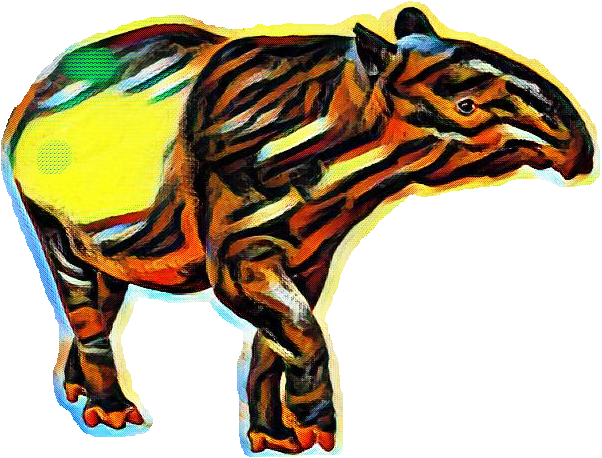One year ago this week I began writing an article. The study seemed to be a fairly open-shut case. Question: does tapir postcranial variation vary exclusively with body size. Answer: probably not. Easy. Simple. Attach a p-value to that and off you go. He thought. But like that great Gallifreyan statement always goes, it turned out this study was bigger on the inside…
The premise of this study lies in the long-held belief that tapirs and their closest relatives within the Tapiroidea (e.g. Heptodon, Helaletes etc.) vary very little in their postcranial morphology, except as a direct consequence of increases in body size. This idea was posited by Radinsky in the 1960s, and has largely remained ‘gospel’ without quantitative assessment. My early work on modern tapirs (Maclaren & Nauwelaerts 2016; 2017) had already thrown doubt on this concept, but without a larger sample size than the four modern species of tapir, any claims contradicting the status quo would have been poorly substantiated. Enter Dr. Richard Hulbert and the Florida Museum of Natural History.
 After much organisation I found myself in Florida for two months in early 2017, with a laser scanner and a mountain of extinct tapir bones to scan! These are located at Dickinson Hall, the home of the FLMNH collections (image). The Miocene, Pliocene and Pleistocene deposits in Florida are a hot-spot for tapir fossils (all currently recognised in the genus Tapirus), with at least five species identified with others possibly present. These include the long-limbed “savannah” tapir Tapirus webbi, the small Blancan endemic T. lundeliusi and the Miocene dwarf tapir T. polkensis (to read more about these taxa by clicking on the names). During my stay I was also fortunate enough to be invited to the Gray Fossil Site & General Shale Museum in Johnson City, Tennessee (image below). This is a world-famous locality for the dwarf tapir – which was obviously a vital inclusion for a study on body size and scaling!
After much organisation I found myself in Florida for two months in early 2017, with a laser scanner and a mountain of extinct tapir bones to scan! These are located at Dickinson Hall, the home of the FLMNH collections (image). The Miocene, Pliocene and Pleistocene deposits in Florida are a hot-spot for tapir fossils (all currently recognised in the genus Tapirus), with at least five species identified with others possibly present. These include the long-limbed “savannah” tapir Tapirus webbi, the small Blancan endemic T. lundeliusi and the Miocene dwarf tapir T. polkensis (to read more about these taxa by clicking on the names). During my stay I was also fortunate enough to be invited to the Gray Fossil Site & General Shale Museum in Johnson City, Tennessee (image below). This is a world-famous locality for the dwarf tapir – which was obviously a vital inclusion for a study on body size and scaling!
 With over 250 North American fossil specimens scanned, I felt my work was worthy of consideration. But there was more to come! The American Museum of Natural History kindly allowed me to loan the only postcranial material for the giant Asian tapir Tapirus (Megatapirus) augustus. The material included the humerus and radius, which enabled some more representative scaling estimates for two European species I had acquired which were only represented by radii in my dataset – Tapirus arvernensis and T. priscus. With the addition of these three quite different Eurasian species, and of course the comparative material from modern tapirs, my study had as many bases covered as possible.
With over 250 North American fossil specimens scanned, I felt my work was worthy of consideration. But there was more to come! The American Museum of Natural History kindly allowed me to loan the only postcranial material for the giant Asian tapir Tapirus (Megatapirus) augustus. The material included the humerus and radius, which enabled some more representative scaling estimates for two European species I had acquired which were only represented by radii in my dataset – Tapirus arvernensis and T. priscus. With the addition of these three quite different Eurasian species, and of course the comparative material from modern tapirs, my study had as many bases covered as possible.
 Finally, it was time to test the hypothesis of post-cranial morphology and scaling. I only used the forelimb for this analysis, both because the forelimb is more heavily involved in gravitational support in perissodactyls (including tapirs) than the hind limb, and (to be honest) that is the comparative dataset I have accumulated over the past four years! As far as the forelimb is concerned, the results strongly suggest that there is more at play in post-cranial morphological diversity of tapirs than just a size effect. So when you look at Tapir ARm Diversity In time and Space – which I know you all will now – just remember: a TARDIS is bigger (and far more complicated) once you look into it!
Finally, it was time to test the hypothesis of post-cranial morphology and scaling. I only used the forelimb for this analysis, both because the forelimb is more heavily involved in gravitational support in perissodactyls (including tapirs) than the hind limb, and (to be honest) that is the comparative dataset I have accumulated over the past four years! As far as the forelimb is concerned, the results strongly suggest that there is more at play in post-cranial morphological diversity of tapirs than just a size effect. So when you look at Tapir ARm Diversity In time and Space – which I know you all will now – just remember: a TARDIS is bigger (and far more complicated) once you look into it!
Full details can be accessed on my Journal Articles page, with full-texts on request from my ResearchGate page. Or if those don’t take your fancy, check out the official page from the Zoological Journal of the Linnean Society. If you are confused by the concept of a TARDIS, I recommend clicking here…you’re missing out!

